
The M109 is an American 155 mm turreted self-propelled howitzer, first introduced in the early 1960s to replace the M44. It has been upgraded a number of times, most recently to the M109A7. The M109 family is the most common Western indirect-fire support weapon of maneuver brigades of armored and mechanized infantry divisions.
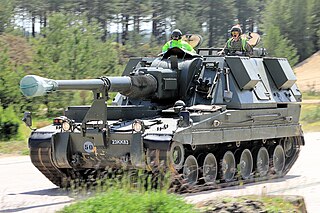
The AS-90, known officially as Gun Equipment 155 mm L131, is an armoured self-propelled artillery used by the British Army.

The Panzerhaubitze 2000, meaning "armoured howitzer 2000" and abbreviated PzH 2000, is a German 155 mm self-propelled howitzer developed by Krauss-Maffei Wegmann (KMW) and Rheinmetall in the 1980s and 1990s for the German Army. The PzH 2000 has automatic support for up to five rounds of multiple round simultaneous impact. Replenishment of shells is automated. Two operators can load 60 shells and propelling charges in less than 12 minutes. The PzH 2000 equips the armies of Germany, Italy, Ukraine, Netherlands, Greece, Lithuania, Hungary, Qatar and Croatia, mostly replacing older systems such as the M109 howitzer. In November 2019, a PzH 2000 L52 gun fired a shell a distance of almost 67 km (42 mi). As of 2020, a prototype L52 gun with a new charge is being tested for a range of at least 75 km (47 mi).

The 2S19 Msta-S is a 152.4 mm self-propelled howitzer designed and manufactured by Uraltransmash in the Soviet Union and later in Russia, which entered service in 1989 as the successor to the 2S3 Akatsiya. The vehicle has the running gear of the T-80, but is powered by the T-72's diesel engine.

The Field Artillery Branch is the field artillery branch of the United States Army. This branch, alongside the Infantry and Cavalry branches, was formerly considered to be one of the "classic" combat arms branches, but is today included within the "Maneuver, Fires and Effects" (MFE) classification, in accordance with current U.S. Army organizational doctrine.
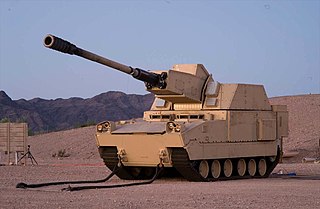
The XM1203 Non-Line-of-Sight Cannon (NLOS-C) was a 155 mm self-propelled howitzer. It was the lead vehicle for the U.S. Army's Future Combat Systems Manned Ground Vehicles program.

The M777 howitzer is a towed 155 mm artillery piece in the howitzer class. It is used by the ground forces of Australia, Canada, Colombia, India, Saudi Arabia, Ukraine, and the United States. It was first used in combat during the War in Afghanistan.

The M982 Excalibur is a 155 mm extended-range guided artillery shell developed in a collaborative effort between the U.S. Army Research Laboratory (ARL) and the United States Army Armament Research, Development and Engineering Center (ARDEC). The Excalibur was developed and/or manufactured by prime contractor Raytheon Missiles & Defense, BAE Systems AB and other subs and primes in multiple capacities such as Camber Corporation and Huntington Ingalls Industries. It is a GPS and inertial-guided munition capable of being used in close support situations within 75–150 meters (250–490 ft) of friendly troops or in situations where targets might be prohibitively close to civilians to attack with conventional unguided artillery fire. In 2015, the United States planned to procure 7,474 rounds with a FY 2015 total program cost of US$1.9341 billion at an average cost of US$258,777 per unit. By 2016, unit costs were reduced to US$68,000 per round. Versions that add laser-guidance capability and are designed to be fired from naval guns began testing in 2015. By October 2018, over 1,400 rounds had been fired in combat.

The DANA (Dělo automobilní nabíjené automaticky is a wheeled self-propelled artillery piece. It is also known as the Samohybná Kanónová Húfnica vzor 77. It was designed by Konštrukta Trenčín and built by ZTS Dubnica nad Váhom in the former Czechoslovakia. Introduced in the 1970s, it was the first wheeled 152 mm self-propelled artillery gun to enter service. It is based on a modified eight-wheel drive Tatra 815 chassis with excellent cross-country mobility. Currently it is in service with the Czech Republic, Libya, Poland, Georgia, Azerbaijan, Slovakia, and Ukraine.
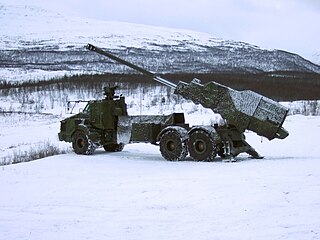
The Archer Artillery System, or Archer – FH77BW L52, or Artillerisystem 08, is a Swedish self-propelled howitzer system. The main piece of the system is a fully automated 155 mm L52 (52-calibre-long) gun-howitzer and a M151 Protector remote-controlled weapon station mounted on a modified 6×6 chassis of the Volvo A30D all-terrain articulated hauler. The crew and engine compartment is armoured and the cab is fitted with bullet and fragmentation-resistant windows. The system also includes an ammunition resupply vehicle, a support vehicle, BONUS submunitions, and M982 Excalibur guided projectiles.
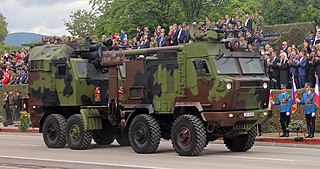
The Nora B-52 is a 155 mm self-propelled howitzer developed by Military Technical Institute and manufactured by Yugoimport SDPR in Velika Plana, Serbia.
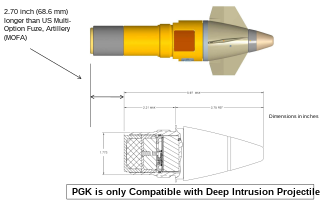
The M1156 Precision Guidance Kit (PGK), formerly XM1156, is a U.S. Army-designed precision guidance system to turn existing 155 mm artillery shells into smart weapons. The prime contractor was Alliant Techsystems – later merging with Orbital Sciences Corporation to form Orbital ATK, in turn being taken over by Northrop Grumman and renamed Northrop Grumman Innovation Systems – and the industry team includes Interstate Electronics Corporation. By April 2018, more than 25,000 PGKs had been produced.

The 2K25 Krasnopol is a Soviet 152/155 mm cannon-launched, fin-stabilized, base bleed-assisted, semi-automatic laser-guided artillery weapon system. It automatically 'homes' on a point illuminated by a laser designator, typically operated by a drone or ground-based artillery observer. Krasnopol projectiles are fired mainly from Soviet self-propelled howitzers such as the 2S3 Akatsiya and 2S19 Msta-S and are intended to engage small ground targets such as tanks, other direct fire weapons, strong-points, or other significant point targets visible to the observer. It can be used against both stationary and moving targets.

The Rocket Forces and Artillery of the Ukrainian Ground Forces consist of units armed with tactical missiles, howitzers, cannons, mortars, jet-propelled and anti-tank artillery. They are tasked to destroy human resources, tanks, artillery, anti-tank weapons, aircraft, air defense and other important installations operations.
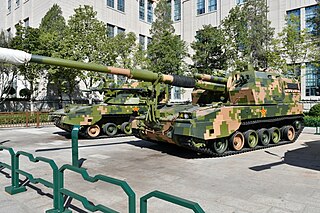
The PLZ-05 or the Type 05 is a 155 mm self-propelled howitzer developed by the People's Liberation Army of China to replace the Type 59-1 130 mm towed gun and Type 83 152 mm self-propelled gun. The PLZ-05 was officially unveiled at the Military Museum of the Chinese People's Revolution to mark the 80th anniversary of the PLA in July 2007, and first entered service with the PLA in 2008.

ATMOS is a 155 mm/52 calibre self-propelled gun system manufactured by Israeli military manufacturer Soltam Systems.

The M44 was an American-made self-propelled 155 mm howitzer based on the M41 Walker Bulldog tank chassis, first introduced in the early 1950s. Flaws in its design prevented it from seeing action in the Korean War, but the type went on to serve in the armies of the United States, West Germany, Italy, and the United Kingdom into the late Cold War period, and even longer in Turkish service.

The 2S22 Bohdana is a 155 mm NATO-standard artillery caliber, wheeled self-propelled howitzer developed in Ukraine. It is mounted on the chassis of the Ukrainian six-wheel-drive KrAZ-6322 truck. It has an armoured double cabin and storage for around 20 shells. The howitzer has a minimum range of 780 meters, and a maximum range of 42 km with HE/AP ammunition or 50 km with a rocket-assisted projectile. It is capable of firing M982 Excalibur artillery shells and it can fire 5 rounds per minute.
The Field Artillery Rationalisation Plan is a procurement-cum-development plan of the Indian Army. The programme was drafted in 1999 in the aftermath of the Kargil war, emboldened by the success of the 155mm Bofors guns in its inventory. The programme was slated to replace the weapons of 169 artillery regiments with modern weapon systems, predominantly of 155mm calibre. The procurement involves direct import, manufacture under license, as well as inhouse development of artillery weapon systems.



















